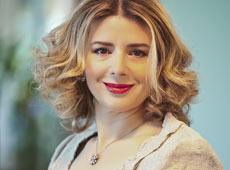Συνέντευξη της Δρ. Αθηνάς Βούρτση στα πλαίσια του EUSOBI 2016, Βιέννη -Αυστρία
Με τον τίτλο «Νέος Ορίζοντας στην Υγεία του Μαστού», η Δρ. Αθηνά Βούρτση μιλά για το νέο διαγνωστικό «εργαλείο», το Invenia™ ABUS (Automated Breast Ultrasound System), που εφαρμόζεται σε γυναίκες με πυκνούς μαστούς. Το υπερηχογράφημα με Invenia ABUS, επιτρέπει στους ακτινοδιαγνώστες να έχουν πιο ξεκάθαρη εικόνα και να νιώσουν πιο ασφαλείς ως προς τη διαγνωστική ακρίβεια του καρκίνου, συγκριτικά με την εικόνα που θα είχαν εάν έκαναν μόνο μαστογραφία.
A New Horizon for Breast Health
Breast Cancer is the most common cancer among women worldwide[1] and in Europe alone, around 131,000 women die from breast cancer every year. But thanks to the efforts of scientists and product designers, this rate is falling. We now know more about breast cancer, and how to fight it, than ever before.
However, it can take some time for knowledge to turn into action. Dr. Athina Vourtsis, MD, PhD, Radiologist and President of the Hellenic Breast Imaging Society in Greece, has worked in breast health for twenty years and has become one of the top experts in the field.
Since 1997 she has focused exclusively on the diagnosis of breast diseases. She reads over 4,500 mammograms, performs over 3,500 breast ultrasounds and more than 200 interventional procedures every year.
At her private practice, Dr. Vourtsis uses latest technology that she feels gives her the best chance at spotting cancer at the earliest stage possible. To complement mammography examinations, she uses breast ultrasound as she feels this enables her to identify additional hard-to-spot tumors, especially in women with dense breasts.
“In Greece, we do not have a national screening program,” said Dr. Vourtsis. “This has given me the opportunity to integrate personalized breast imaging into my own practice.”
“In women with dense breasts, we know that mammography has certain limitations. In order to overcome these, it is necessary to implement breast ultrasound. I use the Invenia™ ABUS (Automated Breast Ultrasound System), and I feel much more confident in my interpretation and in the accurate diagnosis of the disease than I would have with mammography alone.”
“I believe it has opened a new horizon for breast cancer screening.”

Breast density is a measurement of the amount fatty tissue versus the amount of fibrous tissue in the breast. The more connective tissue there is, the denser the breast tissue is and the whiter it will look on a mammogram. Both cancer and dense tissue show up white on a mammogram, so looking for tumors in women with this natural breast tissue variation can be like looking for a snowball in a snowstorm.
On ultrasound, cancer appears black, and stands out from fibrous tissue. Developed to help doctors find cancers hidden in dense breast tissue, ABUS technology is designed for screening women with dense breasts as an adjunct to mammography. It has shown a 55% relative increase in detecting invasive breast cancers in women with dense breasts over mammography alone[2].
“Some cancers are obscured in mammograms of dense breasts, and can be missed. However, with ABUS, we find more breast cancers far sooner than we would have without ultrasound.”
Another factor helping more Greek women catch cancer earlier is raised awareness. “Greek women are very well-informed,” added Dr. Vourtsis. “Not just through the media, but also through the Panhellenic Breast Cancer Awareness Society, called Alma Zois.”
“Of course, if women feel a lump they will come in with anxiety. But we are seeing women being much more confident now, when they come to be screened. I’m pleased to say that most women I see are well aware of the necessity of ultrasound and the fact that it should be used to complement mammography if they have dense breasts.”
By catching cancers earlier, many women’s stories could be very different. This year’s European Congress of Radiology (ECR) in Vienna gives healthcare companies the chance to showcase the latest and best in breast health technology.
As the battle against breast cancer progresses, the way we diagnose and treat it is constantly evolving. Stay tuned to The Pulse @ECR to find out more as we bring the latest news and live video from the trade show floor.
[1] U.S.A data Source: National Breast Cancer Foundation, Inc.
[2] Assessing Improvement in Detection of Breast Cancer with Three-dimensional Automated Breast US in Women with Dense Breast Tissue: The SomoInsight Study. (Authors: Rachel F. Brem, MD, László Tabár, MD, Stephen W. Duffy, MSc, Marc F. Inciardi, MD, Jessica A. Guingrich, MD, Beverly E. Hashimoto, MD, Marla R. Lander, MD, Robert L. Lapidus, MD, Mary Kay Peterson, MD, Jocelyn A. Rapelyea, MD, Susan Roux, MD, Kathy J. Schilling, MD, Biren A. Shah, MD, Jessica Torrente, MD, Ralph T. Wynn, MD, Dave P. Miller, MS)
™ Trademark of General Electric Company
